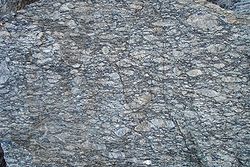
Augen
Encyclopedia

Mineral
A mineral is a naturally occurring solid chemical substance formed through biogeochemical processes, having characteristic chemical composition, highly ordered atomic structure, and specific physical properties. By comparison, a rock is an aggregate of minerals and/or mineraloids and does not...
grains or mineral aggregate
Aggregate (composite)
Aggregate is the component of a composite material that resists compressive stress and provides bulk to the composite material. For efficient filling, aggregate should be much smaller than the finished item, but have a wide variety of sizes...
s visible in some foliated
Foliation (geology)
Foliation is any penetrative planar fabric present in rocks. Foliation is common to rocks affected by regional metamorphic compression typical of orogenic belts. Rocks exhibiting foliation include the standard sequence formed by the prograde metamorphism of mudrocks; slate, phyllite, schist and...
metamorphic rocks. In cross section they have the shape of an eye.
Feldspar
Feldspar
Feldspars are a group of rock-forming tectosilicate minerals which make up as much as 60% of the Earth's crust....
, quartz
Quartz
Quartz is the second-most-abundant mineral in the Earth's continental crust, after feldspar. It is made up of a continuous framework of SiO4 silicon–oxygen tetrahedra, with each oxygen being shared between two tetrahedra, giving an overall formula SiO2. There are many different varieties of quartz,...
, and garnet
Garnet
The garnet group includes a group of minerals that have been used since the Bronze Age as gemstones and abrasives. The name "garnet" may come from either the Middle English word gernet meaning 'dark red', or the Latin granatus , possibly a reference to the Punica granatum , a plant with red seeds...
are common minerals which form augen.
Augen form in rocks which have undergone metamorphism and shearing. The core of the augen is a porphyroblast
Porphyroblast
A porphyroblast is a large mineral crystal in a metamorphic rock which has grown within the finer grained groundmass. Porphyroblasts are commonly euhedral crystals, but can also be partly to completely irregular in shape....
or porphyroclast
Porphyroclast
thumb|350px|right|A [[mylonite]] showing a number of porphyroclasts: a clear red [[garnet]] left in the picture while smaller white [[feldspar]] porphyroclasts can be found all over...
of a hard, resilient mineral such as garnet. The augen grows by crystallisation of a mantle of new mineral around the porphyroblast. The mantle is formed contiguous with the foliation which is imparted upon the rock, and forms a blanket which tapers off from either side of the porphyroblast within the strain shadows.
During shearing, the poprhyroblast may rotate, to form a characteristic augen texture of asymmetric shearing. In this case, the position of the tails is unequal across the foliation, with some augen showing clear drag folding of the mantle into the strain shadow. This derives a form of shear direction information.
A metamorphic rock which is clotted with augen is often called an augen gneiss. A long wall of this augen gneiss can be felt at the Mineral and Lapidary Museum
Mineral and Lapidary Museum
The Mineral and Lapidary Museum of Henderson County is a volunteer-run museum in Hendersonville, North Carolina founded in 1997 at 400 North Main Street in the middle of the city's Historic District....
of Western North Carolina
Western North Carolina
Western North Carolina is the region of North Carolina which includes the Appalachian Mountains, thus it is often known geographically as the state's Mountain Region. It is sometimes included with upstate South Carolina as the "Western Carolinas", which is also counted as a single media market...
.
See also
- FoliationFoliationIn mathematics, a foliation is a geometric device used to study manifolds, consisting of an integrable subbundle of the tangent bundle. A foliation looks locally like a decomposition of the manifold as a union of parallel submanifolds of smaller dimension....
- GneissGneissGneiss is a common and widely distributed type of rock formed by high-grade regional metamorphic processes from pre-existing formations that were originally either igneous or sedimentary rocks.-Etymology:...
- Rock microstructureRock microstructureRock microstructure includes the texture of a rock and the small scale rock structures. The words "texture" and "microstructure" are interchangeable, with the latter preferred in modern geological literature...
- SchistSchistThe schists constitute a group of medium-grade metamorphic rocks, chiefly notable for the preponderance of lamellar minerals such as micas, chlorite, talc, hornblende, graphite, and others. Quartz often occurs in drawn-out grains to such an extent that a particular form called quartz schist is...
- Shear (geology)

